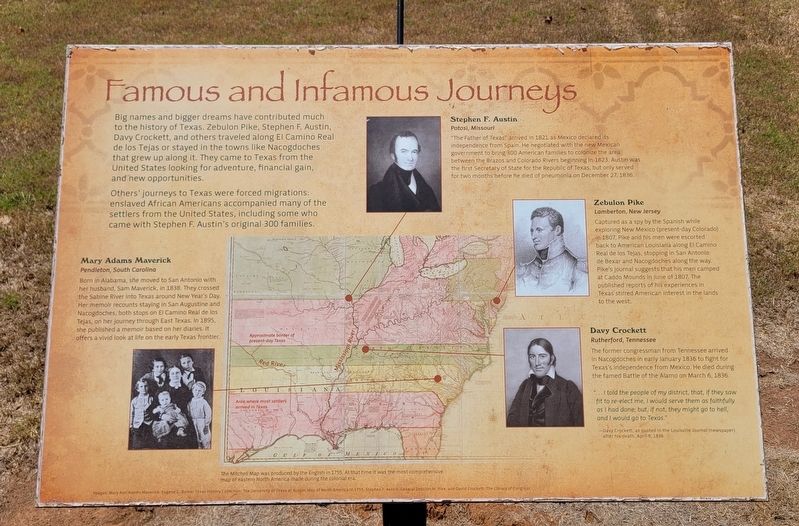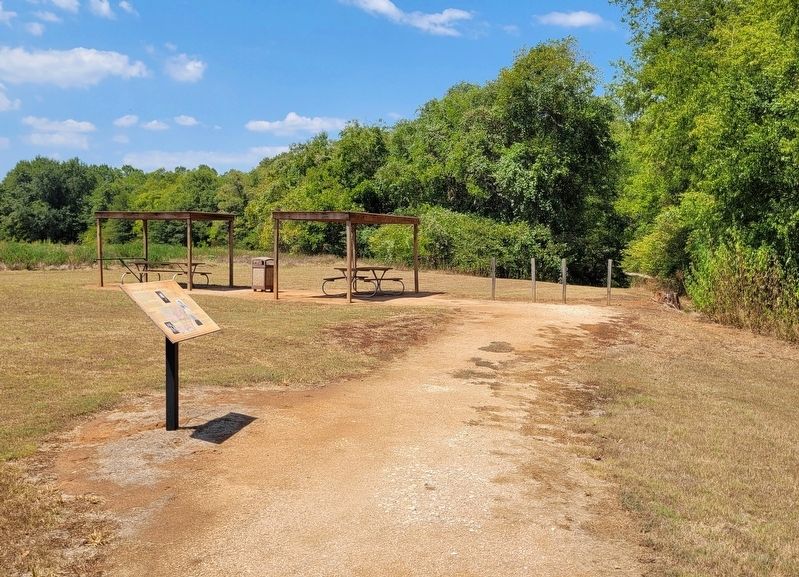Near Alto in Cherokee County, Texas — The American South (West South Central)
Famous and Infamous Journeys
Others' journeys to Texas were forced migrations: enslaved African Americans accompanied many of the settlers from the United States, including some who came with Stephen F. Austin's original 300 families.
Captions
Mary Adams Maverick
Pendleton, South Carolina
Born in Alabama, she moved to San Antonio with her husband, Sam Maverick, in 1838. They crossed the Sabine River into Texas around New Year's Day. Her memoir recounts staying in San Augustine and Nacogdoches, both stops on El Camino Real de los Tejas, on her journey through East Texas. In 1895, she published a memoir based on her diaries. It offers a vivid look at life on the early Texas frontier.
Stephen F. Austin
Potosi, Missouri
"The Father of Texas" arrived in 1821 as Mexico declared its independence from Spain. He negotiated with the new Mexican government to bring 300 American families colonize the area between the Brazos and Colorado Rivers beginning in 1823. Austin was the first Secretary of State for the Republic of Texas, but only served for two months before he died of pneumonia on December 27, 1836.
Zebulon Pike
Lamberton, New Jersey
Captured as a spy by the Spanish while exploring New Mexico (present-day Colorado) in 1807, Pike and his men were escorted back to American Louisiana along El Camino Real de los Tejas, stopping in San Antonio de Bexar and Nacogdoches along the way. Pike's journal suggests that his men camped at Caddo Mounds in June of 1807. The published reports of his experiences in Texas stirred American interest in the lands to the west.
Davy Crockett
Rutherford, Tennessee
The former congressman from Tennessee arrived in Nacogdoches in early January 1836 to fight for Texas's independence from Mexico. He died during the famed Battle of the Alamo on March 6, 1836.
"...I told the people of my district, that, if they saw fit to re-elect me, I would serve them as faithfully as I had done; but, if not, they might go to hell, and I would go to Texas."
-Davy Crockett, as quoted in the Louisville Journal (newspaper) after his death, April 9, 1836
The Mitchell Map was produced by the English in 1755. At that time it was the most comprehensive map of eastern North America made during the
colonial era.
Images: Mary Ann Adams Maverick: Eugene C. Barker Texas History Collection, The University of Texas at Austin: Map of North America in 1755, Stephen F. Austin, General Zebulon M. Pike, and David Crockett: The Library of Congress
Erected by Caddo Mounds State Historic Site.
Topics. This historical marker is listed in these topic lists: African Americans • Immigration • Roads & Vehicles • Settlements & Settlers. A significant historical date for this entry is December 27, 1836.
Location. 31° 35.951′ N, 95° 9.054′ W. Marker is near Alto, Texas, in Cherokee County. Marker is at the intersection of State Highway 21 and Farm to Market Road 2907 on State Highway 21. The marker is located in the northern section of the Caddo Mounds State Historic Site. Touch for map. Marker is at or near this postal address: 1649 TX-21, Alto TX 75925, United States of America. Touch for directions.
Other nearby markers. At least 8 other markers are within walking distance of this marker. El Camino Real de los Tejas (a few steps from this marker); Zebulon Pike Campsite (a few steps from this marker); A Welcome Rest (about 300 feet away, measured in a direct line); Waystation for Travelers and Traders (about 500 feet away); Travel Encounters (about 500 feet away); Burial Mound (about 600 feet away); Natural Spring (approx. 0.2 miles away); Low Platform Mound (approx. ¼ mile away). Touch for a list and map of all markers in Alto.
More about this marker. The marker is located in the Caddo Mounds State Historic Site and it does require a small entry fee to visit.
Also see . . . Caddo Mounds State Historic Site. Texas State Historical Association (TSHA)
Caddo Mounds State Historic Site, one of the best known and intensively investigated Indian sites in Texas, is on State Highway 21 about six miles southwest of Alto in southern Cherokee County. It comprises much of what is known to archeologists as the George C. Davis Site, the southwesternmost ceremonial center of the Caddoan peoples who flourished on the western edge of the woodlands of eastern North America between 1000 B.C. and A.D. 1550. Caddo Mounds consists of three large earthen mounds, as well as a large portion of a prehistoric village.(Submitted on September 8, 2023, by James Hulse of Medina, Texas.)
Credits. This page was last revised on September 9, 2023. It was originally submitted on September 8, 2023, by James Hulse of Medina, Texas. This page has been viewed 69 times since then and 21 times this year. Photos: 1, 2. submitted on September 9, 2023, by James Hulse of Medina, Texas.

